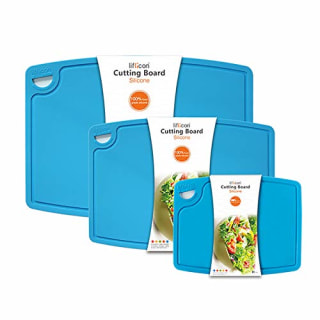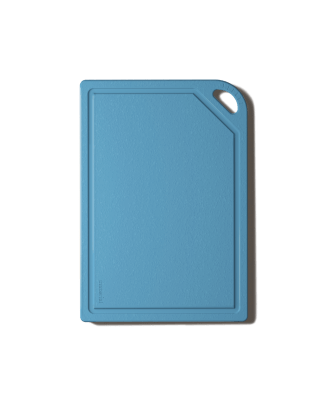Everyone has one: a scratched, stained plastic cutting board that’s been in your kitchen for years. Despite how many times you say to yourself, “I should get a new one,” you never do — but now, it’s officially time to buy a replacement. Research published in Environmental Science & Technology, a peer-reviewed scientific journal, found that plastic cutting boards release tiny pieces of plastic when you chop on them, which can end up in your food.
Before you start panicking, keep reading — I talked to cooking experts and engineers about whether plastic cutting boards are safe to use, and the best alternatives to buy if you want to reduce your exposure to microplastics.
Want more from NBC Select? Sign up for our newsletter, The Selection, and shop smarter.
Are plastic cutting boards safe to use?
Long story short, yes, plastic cutting boards are generally safe to use, according to all the experts I spoke to. However, they can cause microplastics (particles that have a diameter between 1 and 5 mm.) to end up in your food. As a knife’s blade scratches a plastic cutting board’s surface, tiny pieces of plastic get released that stick to your ingredients — they’re too small to see, so you may ingest them, says Dr. Manish Shetty, an assistant professor of chemical engineering at Texas A&M University. Particles that stick to the knife’s blade or cutting board go down the drain when you clean them, so there’s an environmental impact to consider, too. That said, how worried should you be?
“According to the study’s estimation, people could be exposed to about 50 grams of microplastics per year through plastic cutting boards, which seems like a huge amount, but isn’t compared to other sources of microplastics you’re exposed to,” says Wei. “The study also didn’t find any toxicity effects, which is a good sign, and indicates that this is a safe process.”
It’s important to note, however, that the study’s findings are limited — researchers conducted testing on mice and only tracked health effects for about three days after exposure. Plus, microplastics are difficult to quantify — if another team of researchers did the same study, their findings may vary, says Hoaran Wei, an assistant professor in the department of civil and environmental engineering at the University of Wisconsin-Madison. Additional research will allow scientists to make more definitive assessments, but this study is a good starting point. “It makes us think a lot more about our sources of consumption,” says Shetty. “When you talk about microplastics impacting the environment, it can feel like an arm’s length away, if not more. But when you talk about human health, it feels a lot closer.”
The overall takeaway? You’re exposed to microplastics while using plastic cutting boards, but, as far as researchers can tell right now, not in an excessive amount that could pose health risks, says Wei. You can use a cutting board made from an alternative material if you want to cut down your microplastic exposure (I break down the best options below), but all materials have benefits and drawbacks you’ll need to weigh.
How I picked the best plastic cutting board alternatives
While shopping for plastic cutting board alternatives, experts recommend thinking about the following factors, all of which I considered while curating my picks.
- Material: Instead of plastic, choose a cutting board made from wood, rubber, silicone or composite, all of which are food-safe and gentle on knives, experts say. Never use a glass, stone or stainless steel cutting board — these materials are very hard on knives and can damage their blades, says Tracy Zimmermann, an assistant professor of hospitality management who teaches culinary arts at the New York City College of Technology.
- Care: Rubber, silicone and composite cutting boards are easier to clean compared to wood options, says Zimmermann. They’re dishwasher-safe and you can sanitize them with a chemical solution if needed. Wood has antibacterial properties that don’t allow bacteria to grow and fester, but you can’t put these types of cutting boards in the dishwasher or use chemical sanitizers on them. Instead, you hand-wash them with dish soap and water.
- Lifespan: Once there’s deep scratches and nicks, lingering odors or permanent stains on the surface of a rubber, silicone or composite cutting board, you need to retire it. However, you can sand down the surface of wood cutting boards as they get scratched and nicked, so you don’t have to replace them as often.
The best plastic cutting board alternatives for your kitchen
To recommend the best plastic cutting board alternatives, I rounded up options that meet expert guidance. A few also come recommended by chefs or the NBC Select staff. I didn’t include any rubber cutting boards below — they’re a great alternative for plastic boards, but experts say they’re most often used in professional kitchens, not at home.
Best wood
“Wood is always a great choice due to its antimicrobial properties,” says Zimmermann. “It also has a better feel and is easier on knife blades compared to plastic.” However, these types of cutting boards require some upkeep — you need to oil or condition them periodically to make sure they stay in good shape. Additionally, wood cutting boards absorb moisture, so they’re not great for cutting ingredients like raw meat and fish, says Alycia Johnson, vice president of merchandising at Sur La Table. (Ed’s note: The inclusion of products sold by Sur La Table in this article was made independently of Johnson.)
When she’s cooking at home, Zimmermann says her first choice for a cutting board is this one from Boos, which is double-sided and comes in various shapes, styles and sizes. “They’re the gold standard for wood, and very thick and sturdy,” she says. “I don’t mind taking time to care for it because it’s a superior product.” NBC Select updates editor Mili Godio also swears by her Boos board. “I got it around 6 years ago as a gift for my husband who loves to cook, and I firmly believe it’ll last me 60 more years,” she says. “The quality is unmatched; despite using it to cut hundreds of vegetables and other foods, it still looks incredibly sturdy and durable. Yes, there are knife marks here and there, but overall, it looks great compared to others I’ve tried.” The brand recommends oiling its cutting board at least once a month and conditioning it for additional protection — you can buy a care set separately.
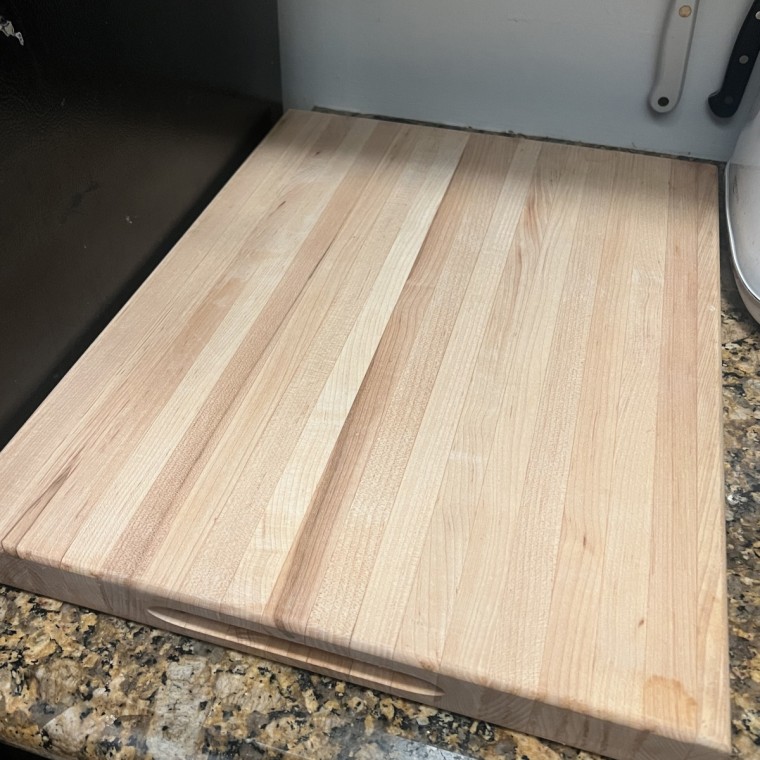
Best composite
“Composite wood fiber cutting boards are quite popular right now because they’re so durable and good on your knives,” says Johnson. “They’re also really easy to clean since you can throw them in the dishwasher.” Zimmermann specifically recommends Epicurean’s composite cutting board, which I also own. “I’ve had it for quite a while and it cuts well, is lightweight and more eco-friendly than plastic,” says Zimmermann. The non-porous boards have a smooth feel and are double-sided, plus there’s a hole to hang them from. They’re heat-resistant up to 350 degrees Fahrenheit, so they double as a trivet, and come in four sizes.
Best silicone
Similar to wood, silicone has some give, making it easy on knife blades, and similar to plastic, it’s dishwasher-safe and inexpensive, says Zimmermann. However, silicone isn’t the sturdiest material, so when you pick the board up, it tends to bend. That might be appealing to you — you can fold silicone cutting boards horizontally or vertically to create a funnel of sorts, making it convenient to dump food into pans or scraps into the trash.
This set comes with three thick silicone cutting boards in small, medium and large sizes. The boards are stain- and stick-resistant, according to the brand, and double-sided: the top has a smooth surface with juice grooves, while the bottom is textured to help it grip to your countertop. Each board also has a hole to hang it from. They’re heat-resistant up to 482 degrees Fahrenheit, so they double as trivets.
Best for small spaces
I own numerous cutting boards, but this is by far the one I use most in my small kitchen. It’s the ideal size for my limited countertop space, and it’s quite durable — I’ve sliced fruits, vegetables, cheese and breads on it almost daily for over a year, and it’s still in great condition. The cutting board is finished with food-safe mineral oil and wax, and it has a small indent in one corner to collect juices or put a small bowl of dip or sauce if you’re serving on it. You can buy Caraway’s small cutting board individually or purchase it as part of the brand’s three-piece set, which also comes with a storage organizer. Caraway recommends occasionally applying mineral oil to extend the board’s lifespan.
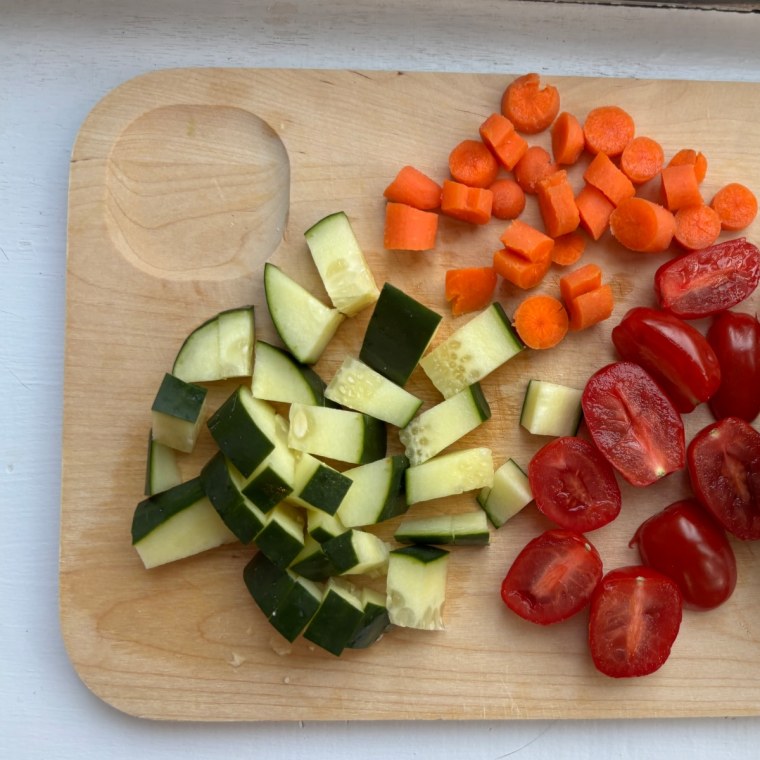
Best for cooking and serving
NBC Select editor Lindsay Schneider uses Our Place’s board (which the brand sent her as a courtesy sample) to prep and serve foods. “As a cutting board, it’s fantastic because it’s really sturdy and heavy, and it has a little trench on the side so liquids don’t spill over,” she says. “I use it as a display board, too. In my small apartment, things have to work double duty, so if I have people over, I use this to put cheese and other snacks on.” The brand recommends occasionally treating the board with food-grade mineral oil to prevent cracking and enhance the surface’s patina over time.
Best plastic-like look and feel
Schneider was a fan of Material Kitchen’s reBoard for years, but ultimately stopped using it since it’s made with plastic. You can now buy a similar plastic-free cutting board from the brand — the new MK Free Board is made from plant-based materials. Its surface is non-pornous and it has a juice groove around its perimeter. There’s also a hole in one corner to hang the board from.
Best hybrid
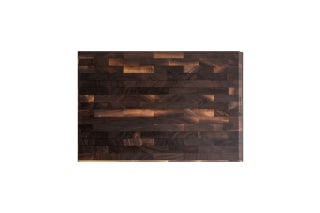
Steelport’s cutting board is one of the more luxe looking options on the market as far as I’m concerned. Plus, it has internal steel beams to prevent it from warping, according to the brand. Each of the board’s sides is made from a different material: one side is wood and the other is composite, giving you the benefits of both. The composite side has a groove around its perimeter to catch juices, and the board’s angled sides make it easy to grab, flip and move as needed.
NBC Select reporter Harry Rabinowitz uses Steelport’s board to cook for his family (the brand sent him a courtesy sample). He appreciates that it’s heavy enough to stay in place on his countertop while chopping, but lightweight enough to easily move around the kitchen and lift onto high shelves .
Meet our experts
At NBC Select, we work with experts who have specialized knowledge and authority based on relevant training and/or experience. We also take steps to ensure that all expert advice and recommendations are made independently and with no undisclosed financial conflicts of interest.
- Dr. Manish Shetty is an assistant professor of chemical engineering at Texas A&M University.
- Hoaran Wei is an assistant professor in the department of civil and environmental engineering at the University of Wisconsin-Madison.
- Tracy Zimmermann is an assistant professor of hospitality management who teaches culinary arts at the New York City College of Technology.
- Alycia Johnson is the vice president of merchandising at Sur La Table. (Ed’s note: The inclusion of products sold by Sur La Table in this article was made independently of Johnson.)
- Patrick Guzzle is the vice president of food science for the National Restaurant Association, the organization that writes and publishes ServSafe products.
Why trust NBC Select?
I’m a reporter at NBC Select who has written about kitchen products for five years, including meal prep containers, cookware sets, dinnerware sets, Dutch ovens and air fryers. To write this article, I spoke to five experts about plastic cutting board alternatives and microplastics. Using their guidance, I rounded up the best plastic cutting board alternatives, including expert and NBC Select staff picks.
Catch up on NBC Select’s in-depth coverage of tech and tools, wellness and more, and follow us on Facebook, Instagram, Twitter and TikTok to stay up to date.





